DODGE STRATUS COUPE 2005 2.G Manual Online
Manufacturer: DODGE, Model Year: 2005, Model line: STRATUS COUPE, Model: DODGE STRATUS COUPE 2005 2.GPages: 396
Page 81 of 396
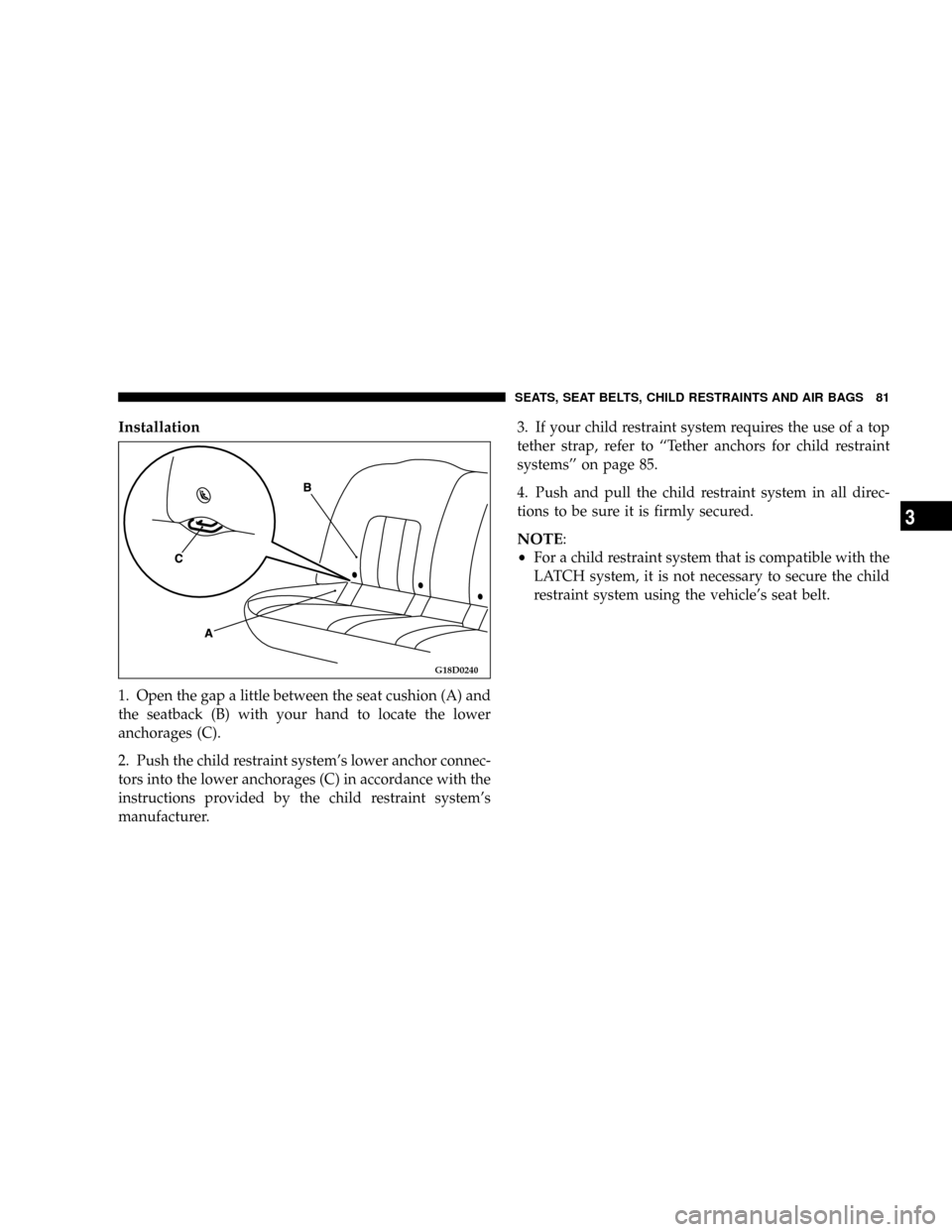
Installation
1. Open the gap a little between the seat cushion (A) and
the seatback (B) with your hand to locate the lower
anchorages (C).
2. Push the child restraint system's lower anchor connec-
tors into the lower anchorages (C) in accordance with the
instructions provided by the child restraint system's
manufacturer.3. If your child restraint system requires the use of a top
tether strap, refer to ``Tether anchors for child restraint
systems'' on page 85.
4. Push and pull the child restraint system in all direc-
tions to be sure it is firmly secured.
NOTE:
²For a child restraint system that is compatible with the
LATCH system, it is not necessary to secure the child
restraint system using the vehicle's seat belt.
G18D0240
SEATS, SEAT BELTS, CHILD RESTRAINTS AND AIR BAGS 81
3
Page 82 of 396
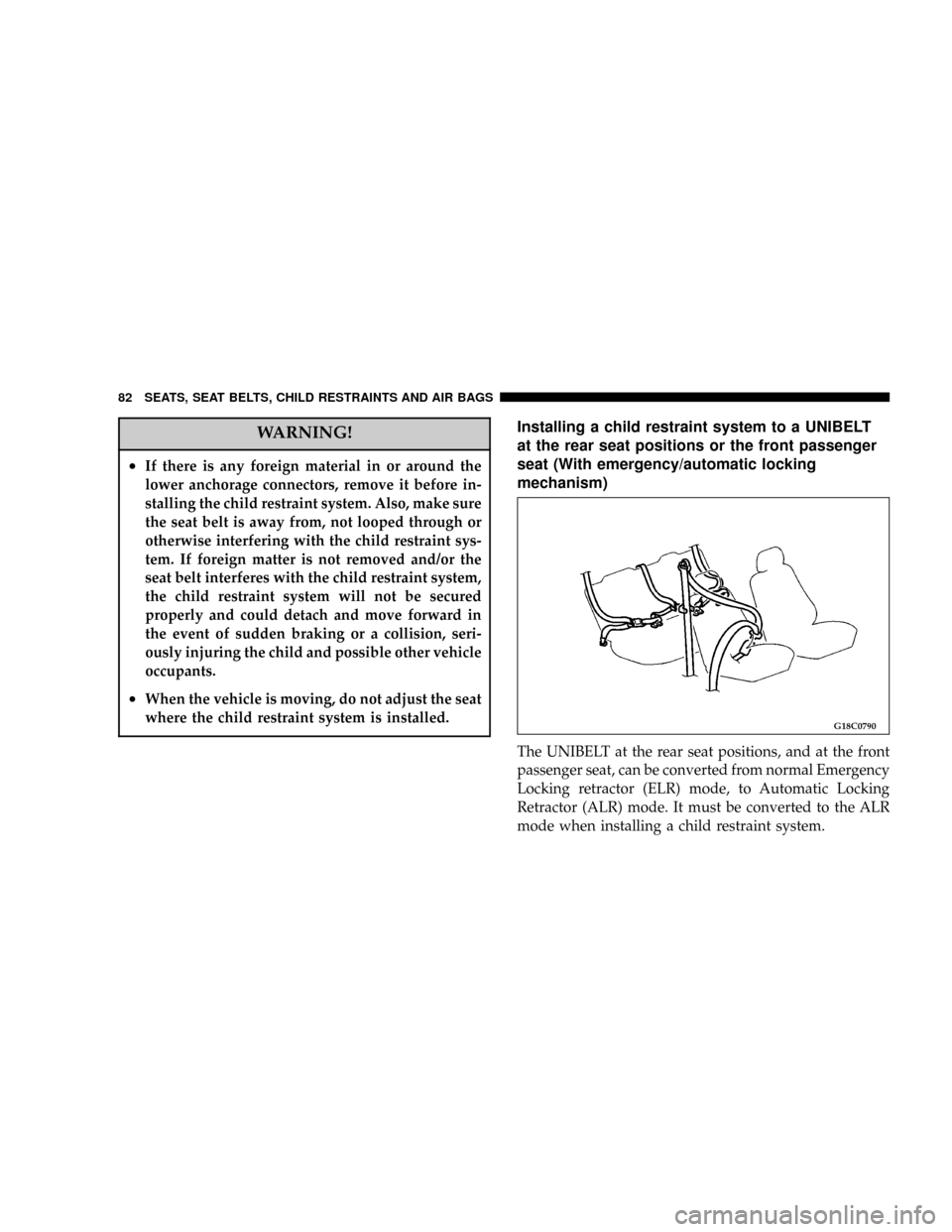
WARNING!
²If there is any foreign material in or around the
lower anchorage connectors, remove it before in-
stalling the child restraint system. Also, make sure
the seat belt is away from, not looped through or
otherwise interfering with the child restraint sys-
tem. If foreign matter is not removed and/or the
seat belt interferes with the child restraint system,
the child restraint system will not be secured
properly and could detach and move forward in
the event of sudden braking or a collision, seri-
ously injuring the child and possible other vehicle
occupants.
²When the vehicle is moving, do not adjust the seat
where the child restraint system is installed.
Installing a child restraint system to a UNIBELT
at the rear seat positions or the front passenger
seat (With emergency/automatic locking
mechanism)
The UNIBELT at the rear seat positions, and at the front
passenger seat, can be converted from normal Emergency
Locking retractor (ELR) mode, to Automatic Locking
Retractor (ALR) mode. It must be converted to the ALR
mode when installing a child restraint system.
G18C0790
82 SEATS, SEAT BELTS, CHILD RESTRAINTS AND AIR BAGS
Page 83 of 396

Children 12 years old and under should be restrained in
the rear seat only, whenever possible, although the front
passenger seat belt can also be the converted to ALR
mode.
WARNING!
²Before placing an infant or child in a child re-
straint system, be absolutely certain you con-
verted the retractor from the ELR mode to the ALR
mode. The ALR mode will keep the child restraint
system tightly secured to the seat.
Failure to convert the retractor to the ALR mode
may allow the child restraint system to move
forward during sudden braking or in a collision,
seriously injuring the child or other occupants.
Installation:
1. Place the child restraint system in the rear seating
position as shown in the illustration.
2. Route the unibelt through the child restraint system
according to the child restraint system manufacturer 's
instructions. Then insert the unibelt latch plate into the
buckle. Make sure you hear a9click9when you insert the
latch plate into the buckle.
G18C0540
SEATS, SEAT BELTS, CHILD RESTRAINTS AND AIR BAGS 83
3
Page 84 of 396

3. To activate the ALR mode, slowly pull the shoulder
part of the belt all the way out until it stops, then let the
belt feed back into the retractor.
4. After the belt has retracted, tug on it. If the belt is
locked, you will not be able to pull it out. If you can pull
the belt out, it is not locked and not in the ALR mode. You
will need to repeat steps 3 and 4.5. After confirming that the belt is locked, grab the
shoulder part of the belt near the buckle and pull up to
remove any slack from the lap part of the belt. Remem-
ber, if the lap part of the belt is not tight, the child
restraint system will not be secure. It may help to put
weight on the child restraint system and/or push on its
seatback while pulling up on the belt (see illustration).
G18C0550G18C0560
84 SEATS, SEAT BELTS, CHILD RESTRAINTS AND AIR BAGS
Page 85 of 396

6. If your child restraint system requires the use of a top
tether strap, refer to ªAnchors for the child restraint
systemº on page 85.
7. Before putting the child in the restraint, push and pull
the restraint in all directions to be sure it is firmly secure.
Do this before each use. If the child restraint system is not
firmly secure, repeat steps 1 through 6.
8. To remove a child restraint system and deactivate the
ALR mode, remove the child from the restraint. Unlatch
the buckle, remove the belt from the restraint and let the
belt fully retract.Tether anchors for the child restraint system
In compliance with the Federal Motor Vehicle Safety
Standards, your vehicle has 3 attachment points on the
rear shelf, located behind the top of your rear seat. For
securing a child seat tether strap to each of the 3 rear
seating positions (2 outer and 1 center) in your vehicle.
G28B1090
SEATS, SEAT BELTS, CHILD RESTRAINTS AND AIR BAGS 85
3
Page 86 of 396
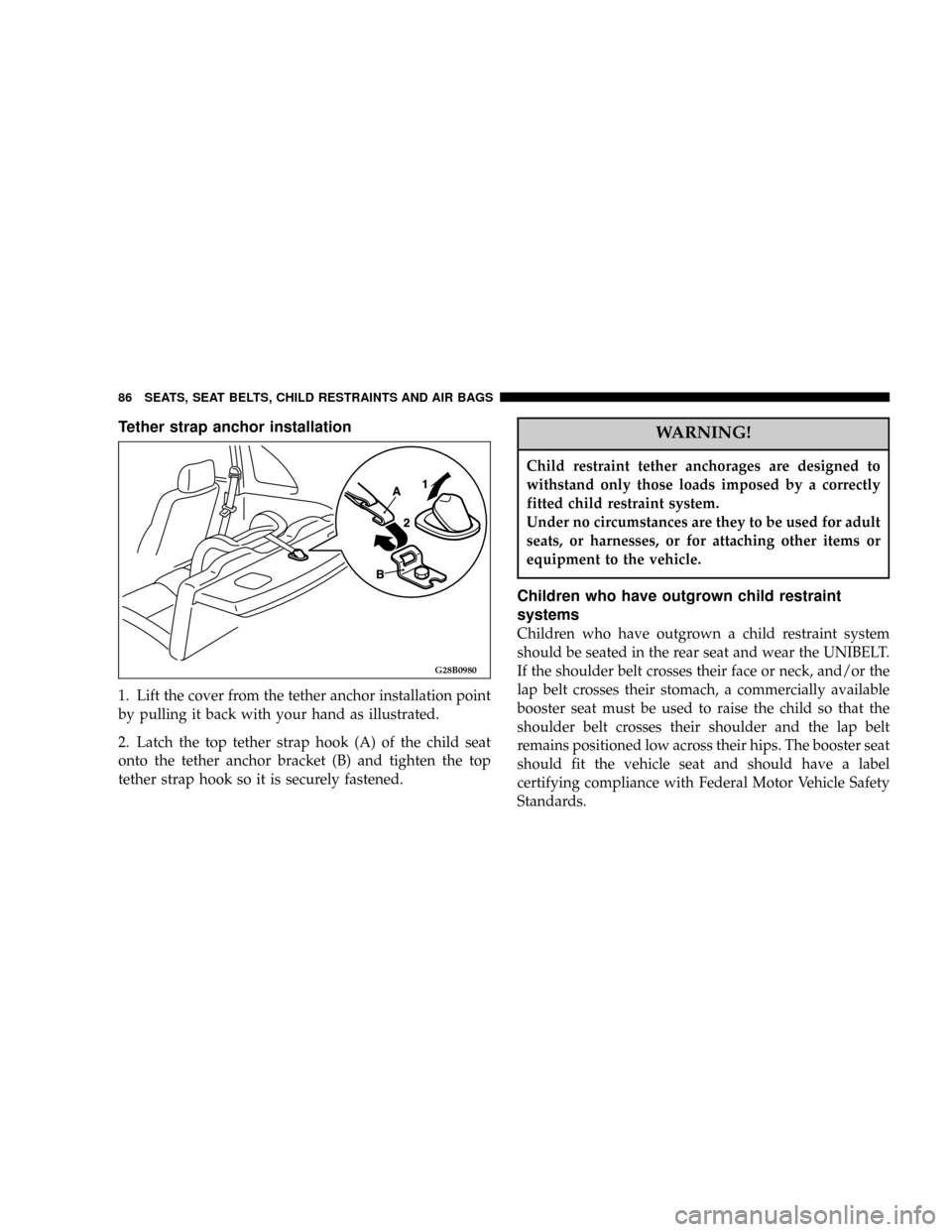
Tether strap anchor installation
1. Lift the cover from the tether anchor installation point
by pulling it back with your hand as illustrated.
2. Latch the top tether strap hook (A) of the child seat
onto the tether anchor bracket (B) and tighten the top
tether strap hook so it is securely fastened.
WARNING!
Child restraint tether anchorages are designed to
withstand only those loads imposed by a correctly
fitted child restraint system.
Under no circumstances are they to be used for adult
seats, or harnesses, or for attaching other items or
equipment to the vehicle.
Children who have outgrown child restraint
systems
Children who have outgrown a child restraint system
should be seated in the rear seat and wear the UNIBELT.
If the shoulder belt crosses their face or neck, and/or the
lap belt crosses their stomach, a commercially available
booster seat must be used to raise the child so that the
shoulder belt crosses their shoulder and the lap belt
remains positioned low across their hips. The booster seat
should fit the vehicle seat and should have a label
certifying compliance with Federal Motor Vehicle Safety
Standards.
G28B0980
86 SEATS, SEAT BELTS, CHILD RESTRAINTS AND AIR BAGS
Page 87 of 396
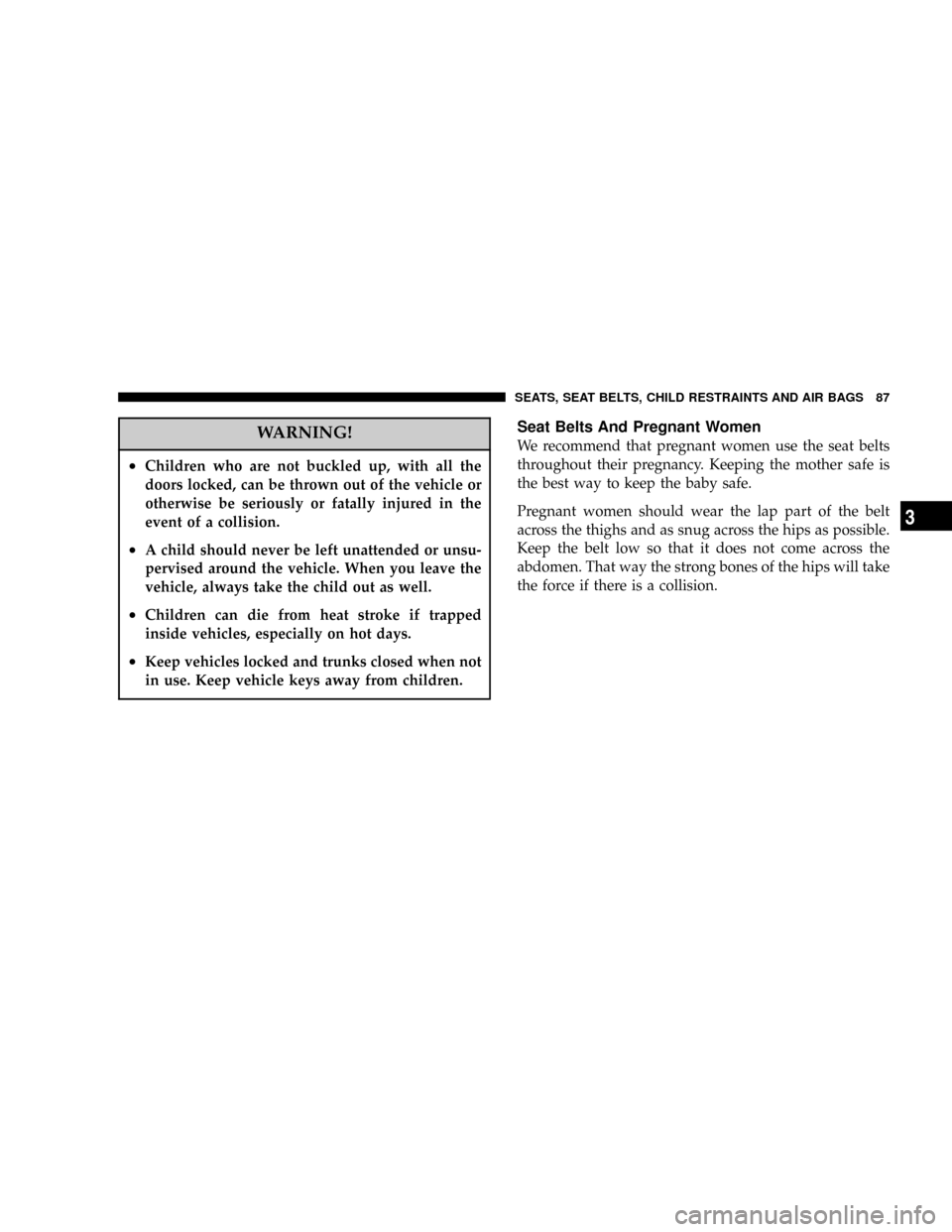
WARNING!
²Children who are not buckled up, with all the
doors locked, can be thrown out of the vehicle or
otherwise be seriously or fatally injured in the
event of a collision.
²A child should never be left unattended or unsu-
pervised around the vehicle. When you leave the
vehicle, always take the child out as well.
²Children can die from heat stroke if trapped
inside vehicles, especially on hot days.
²Keep vehicles locked and trunks closed when not
in use. Keep vehicle keys away from children.
Seat Belts And Pregnant Women
We recommend that pregnant women use the seat belts
throughout their pregnancy. Keeping the mother safe is
the best way to keep the baby safe.
Pregnant women should wear the lap part of the belt
across the thighs and as snug across the hips as possible.
Keep the belt low so that it does not come across the
abdomen. That way the strong bones of the hips will take
the force if there is a collision.
SEATS, SEAT BELTS, CHILD RESTRAINTS AND AIR BAGS 87
3
Page 88 of 396

MAINTENANCE AND INSPECTION OF SEAT
BELTS
The seat belt webbing may be cleaned with mild soap or
detergent solution. Allow the belts to dry in the shade.
Do not allow them to retract until completely dry. Do not
attempt to bleach or re-dye belts. The color may rub off
and webbing strength could be affected.
Regularly check seat belt buckles and release mecha-
nisms for positive action and the retractors when in the
automatic locking retractor mode for positive engage-
ment. Refer to ªInstalling a child restraint system to a
UNIBELTº on page 82.
Check that the anchor mounting bolts are tight. If the seat
belt webbing shows obvious cuts, tears, protruding bro-
ken fibers that cause a local increase in webbing thick-
ness, or severe fading which indicates weakening by
exposure to sunlight, the entire seat belt assembly should
be replaced.The lap belt portion of the front UNIBELT has a sleeve
inside which the belt is folded back over itself in a loop.
This allows the belt to help absorb the energy of a
collision through a controlled release of the loop. In the
event that the loop inside the sleeve has come loose,
replace the entire seat belt assembly.
G28A0420
Good
No GoodSleeve
Sleeve
88 SEATS, SEAT BELTS, CHILD RESTRAINTS AND AIR BAGS
Page 89 of 396
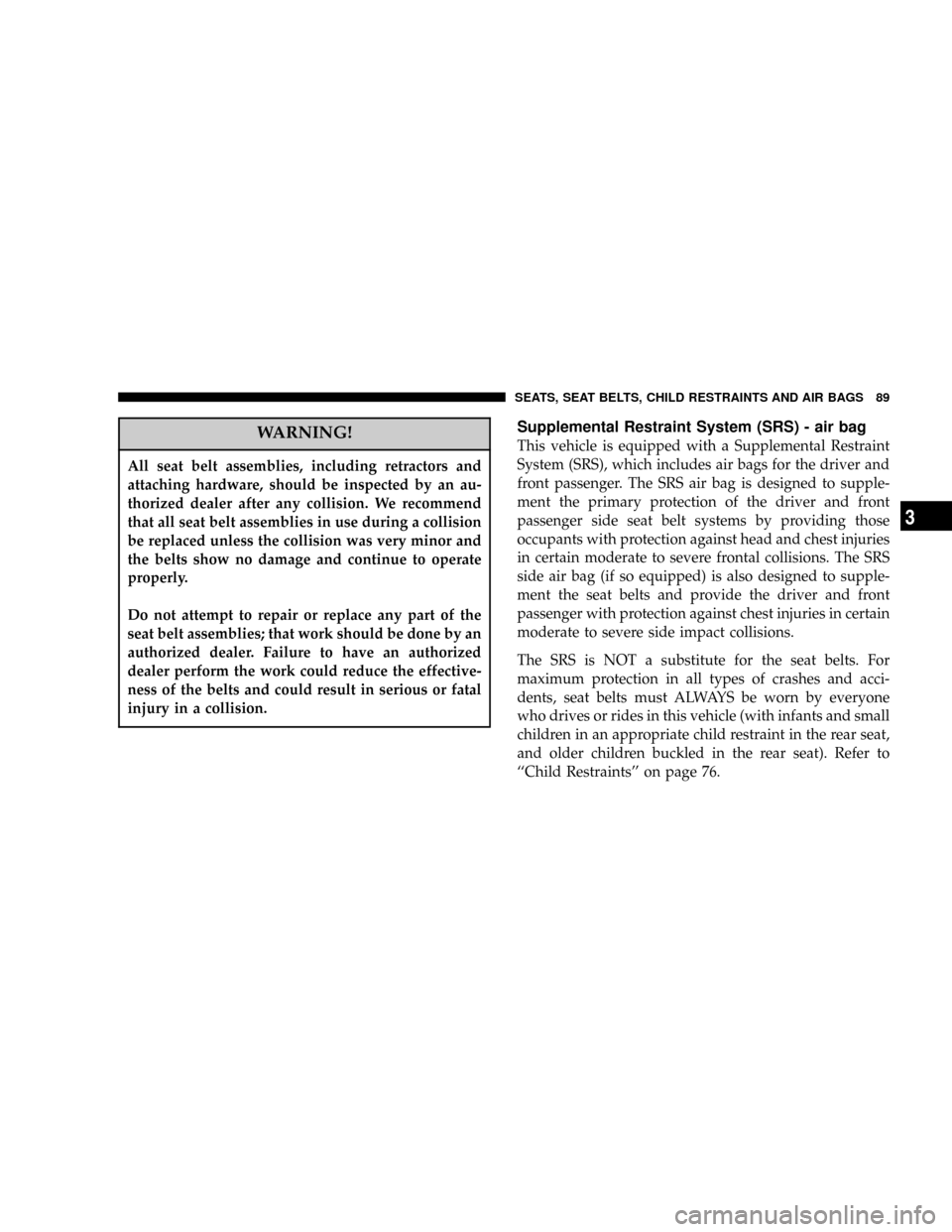
WARNING!
All seat belt assemblies, including retractors and
attaching hardware, should be inspected by an au-
thorized dealer after any collision. We recommend
that all seat belt assemblies in use during a collision
be replaced unless the collision was very minor and
the belts show no damage and continue to operate
properly.
Do not attempt to repair or replace any part of the
seat belt assemblies; that work should be done by an
authorized dealer. Failure to have an authorized
dealer perform the work could reduce the effective-
ness of the belts and could result in serious or fatal
injury in a collision.
Supplemental Restraint System (SRS) - air bag
This vehicle is equipped with a Supplemental Restraint
System (SRS), which includes air bags for the driver and
front passenger. The SRS air bag is designed to supple-
ment the primary protection of the driver and front
passenger side seat belt systems by providing those
occupants with protection against head and chest injuries
in certain moderate to severe frontal collisions. The SRS
side air bag (if so equipped) is also designed to supple-
ment the seat belts and provide the driver and front
passenger with protection against chest injuries in certain
moderate to severe side impact collisions.
The SRS is NOT a substitute for the seat belts. For
maximum protection in all types of crashes and acci-
dents, seat belts must ALWAYS be worn by everyone
who drives or rides in this vehicle (with infants and small
children in an appropriate child restraint in the rear seat,
and older children buckled in the rear seat). Refer to
``Child Restraints'' on page 76.
SEATS, SEAT BELTS, CHILD RESTRAINTS AND AIR BAGS 89
3
Page 90 of 396
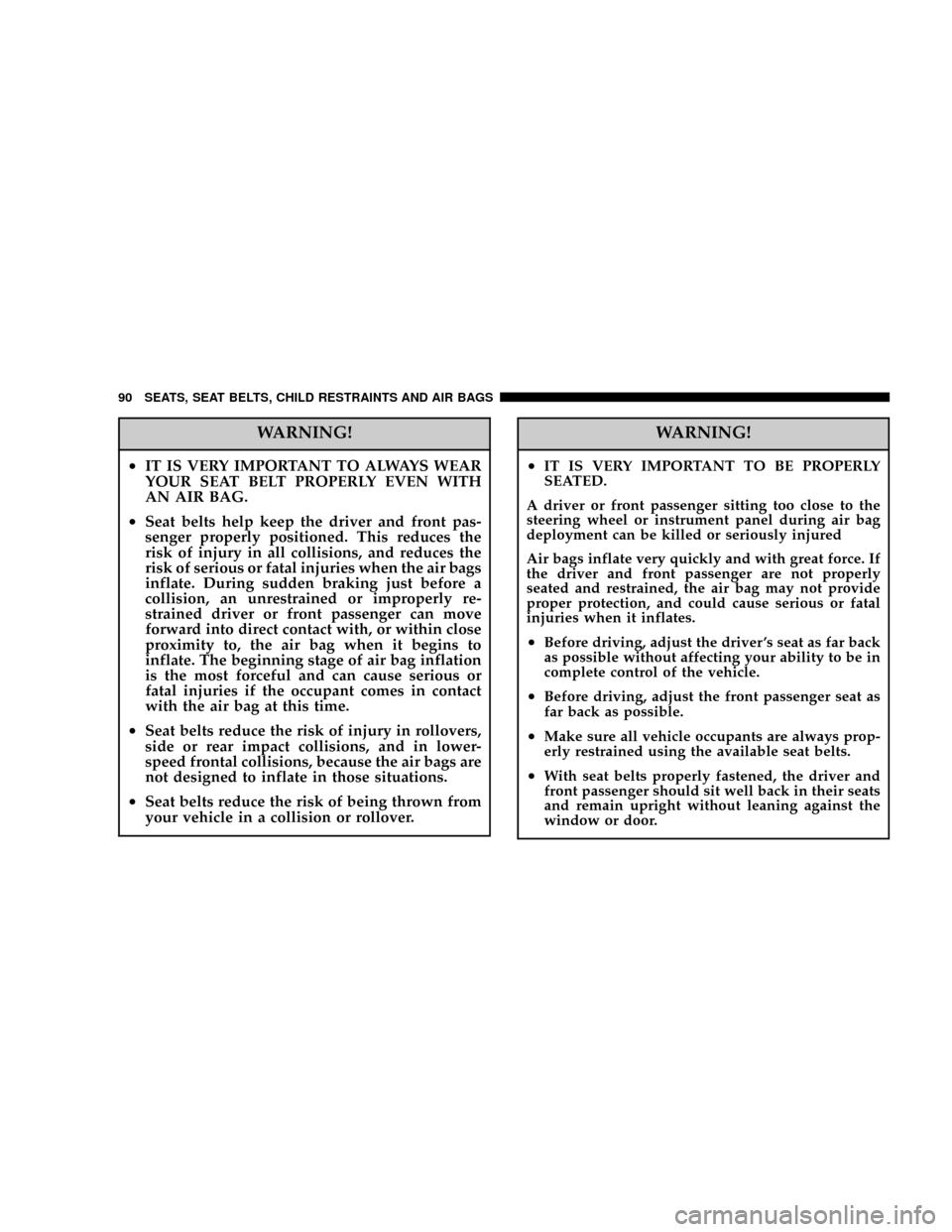
WARNING!
²IT IS VERY IMPORTANT TO ALWAYS WEAR
YOUR SEAT BELT PROPERLY EVEN WITH
AN AIR BAG.
²Seat belts help keep the driver and front pas-
senger properly positioned. This reduces the
risk of injury in all collisions, and reduces the
risk of serious or fatal injuries when the air bags
inflate. During sudden braking just before a
collision, an unrestrained or improperly re-
strained driver or front passenger can move
forward into direct contact with, or within close
proximity to, the air bag when it begins to
inflate. The beginning stage of air bag inflation
is the most forceful and can cause serious or
fatal injuries if the occupant comes in contact
with the air bag at this time.
²Seat belts reduce the risk of injury in rollovers,
side or rear impact collisions, and in lower-
speed frontal collisions, because the air bags are
not designed to inflate in those situations.
²Seat belts reduce the risk of being thrown from
your vehicle in a collision or rollover.
WARNING!
²IT IS VERY IMPORTANT TO BE PROPERLY
SEATED.
A driver or front passenger sitting too close to the
steering wheel or instrument panel during air bag
deployment can be killed or seriously injured
Air bags inflate very quickly and with great force. If
the driver and front passenger are not properly
seated and restrained, the air bag may not provide
proper protection, and could cause serious or fatal
injuries when it inflates.
²Before driving, adjust the driver 's seat as far back
as possible without affecting your ability to be in
complete control of the vehicle.
²Before driving, adjust the front passenger seat as
far back as possible.
²Make sure all vehicle occupants are always prop-
erly restrained using the available seat belts.
²With seat belts properly fastened, the driver and
front passenger should sit well back in their seats
and remain upright without leaning against the
window or door.
90 SEATS, SEAT BELTS, CHILD RESTRAINTS AND AIR BAGS